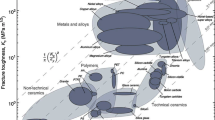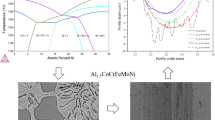Abstract
Compositional patterning in two-phase immiscible alloys during severe plastic deformation at elevated temperatures has been investigated. Kinetic Monte Carlo computer simulations were used to test the proposed idea that patterning derives from a dynamic competition between homogenization by forced chemical mixing and phase separation by thermally activated diffusion [P. Bellon and R.S. Averback, Phys. Rev. Lett.74, 1819 (1995) and F. Wu et al., Acta Mater.54, 2605 (2006)]. We utilize the concept of pair diffusion coefficients to compare thermal diffusion with forced chemical mixing and discuss the fundamentally different behavior with respect to pair separation distance in both mechanisms. While the general ideas of this model are verified and are in good quantitative agreement with our simulations, it is found that the dynamic processes of alloys under high-temperature shear are very complex, even in highly idealized systems, making experimental verification of this model very difficult. We illustrate our findings for a model AB alloy with properties similar to Cu–Ag by showing how alloy morphology and solubility depend on shear rate, temperature, and composition.





Similar content being viewed by others
References
Y. Saito, H. Utsunomiya, N. Tsuji, and T. Sakai: Novel ultra-high straining process for bulk materials - development of the accumulative roll-bonding (ARB) process. Acta Mater. 47, 579 (1999).
C.J. Dawes and W.M. Thomas: Friction stir process welds aluminum alloys. The process produces low-distortion, high-quality, low-cost welds on aluminum. Weld. J. 75, 41 (1996).
D.A. Rigney, L.H. Chen, M.G.S. Naylor, and A.R. Rosenfield: Wear processes in sliding systems. Wear 100, 195 (1984).
M. Sundararaman, W. Chen, R.P. Wahi, A. Wiedenmann, W. Wagner, and W. Petry: TEM and SANS investigation of age hardened nimonic PE16 after cyclic loading at room temperature. Acta Metall. Mater. 40, 1023 (1992).
G. Martin: Transformations de phase et plasticité. Ann. Chim. Fr. 6, 46 (1981).
K. Detemple, O. Kanert, J.T.M. De Hosson, and K.L. Murty: In situ nuclear magnetic resonance investigation of deformation-generated vacancies in aluminum. Phys. Rev. B 52, 125 (1995).
G.J. Dienes and A.C. Damask: Radiation enhanced diffusion in solids. J. Appl. Phys. 29, 1713 (1958).
P. Bellon and R.S. Averback: Nonequilibrium roughening of interfaces in crystals under shear: Application to ball milling. Phys. Rev. Lett. 74, 1819 (1995).
S. Zghal, R. Twesten, F. Wu, and P. Bellon: Electron microscopy nanoscale characterization of ball milled Cu-Ag powders. Part II: Nanocomposites synthesized by elevated temperature milling or annealing. Acta Mater. 50, 4711 (2002).
F. Wu, D. Isheim, P. Bellon, and D.N. Seidman: Nanocomposites stabilized by elevated-temperature ball milling of Ag50Cu50 powders: An atom probe tomographic study. Acta Mater. 54, 2605 (2006).
M. Brocq, B. Radiguet, J-M. Le Breton, F. Cuvilly, P. Pareige, and F. Legendre: Nanoscale characterisation and clustering mechanism in an Fe–Y2O3 model ODS alloy processed by reactive ball milling and annealing. Acta Mater. 58, 1806 (2010).
T. Klassen, U. Herr, and R.S. Averback: Ball milling of systems with positive heat of mixing: Effect of temperature in Ag-Cu. Acta Mater. 45, 2921 (1997).
S. Odunuga, Y. Li, P. Krasnochtchekov, P. Bellon, and R.S. Averback: Forced chemical mixing in alloys driven by plastic deformation. Phys. Rev. Lett. 95, 045901 (2005).
F.J. Delogu: Forced chemical mixing in model immiscible systems under plastic deformation. Appl. Phys. 104, 073533 (2008).
Y. Ashkenazy, N.Q. Vo, D. Schwen, R.S. Averback, and P. Bellon: Shear induced chemical mixing in heterogeneous systems. Acta Mater. 60, 984 (2012).
A. Bachmaier, M. Kerber, D. Setman, and R. Pippan: The formation of supersaturated solid solutions in Fe–Cu alloys deformed by high-pressure torsion. Acta Mater. 60, 860 (2012).
L.S. Tóth, K.W. Neale, and J.J. Jonas: Stress response and persistence characteristics of the ideal orientations of shear textures. Acta Metall. Mater. 37, 2197 (1989).
A.B. Bortz, M.H. Kalos and J.L. Lebowitz: A new algorithm for Monte Carlo simulation of Ising spin systems. J. Comput. Phys. 17, 10 (1975).
A.H. Cottrell: Dislocations and Plastic Flow in Crystals (Oxford University Press, Oxford, 1953), p. 175.
A.R. Yavari: Phase transformations in nanocrystalline alloys. Mater. Sci. Eng. 179, 20 (1994).
Acknowledgments
This research was supported by the U.S. National Science Foundation under Grant Nos. DMR 1005813 and 0906703. Part of this work was performed with support from the Center for Materials at Irradiation and Mechanical Extremes, an Energy Frontier Research Center funded by the US Department of Energy (Grant No. 2008LANL1026) at Los Alamos National Laboratory.
Author information
Authors and Affiliations
Corresponding author
Rights and permissions
About this article
Cite this article
Schwen, D., Wang, M., Averback, R.S. et al. Compositional patterning in immiscible alloys subjected to severe plastic deformation. Journal of Materials Research 28, 2687–2693 (2013). https://doi.org/10.1557/jmr.2013.224
Received:
Accepted:
Published:
Issue Date:
DOI: https://doi.org/10.1557/jmr.2013.224




